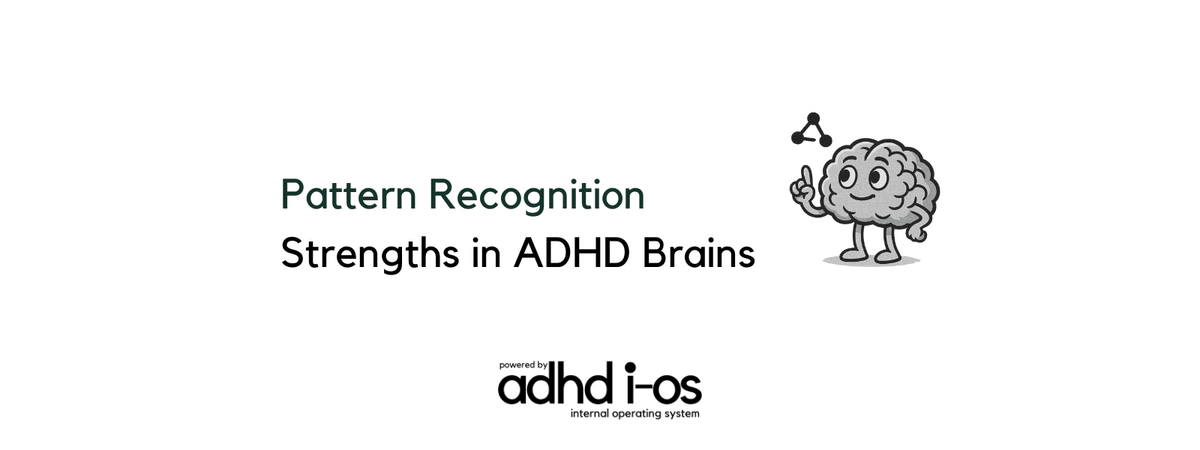Pattern Recognition Strengths in ADHD Brains
Pattern Recognition Strengths in ADHD Brains
Pattern Recognition Strengths in ADHD Brains
Why your brain sees what others don’t, and how to use it.
Ever find yourself connecting dots no one else even sees? Like recognizing a client’s emotional pattern halfway through a conversation or noticing a market trend before it becomes obvious? That’s nyour ADHD brain doing what it does best: scanning, connecting, decoding.
One of the most underrated ADHD superpowers is pattern recognition, the ability to see relationships, trends, and systems in places others overlook.
This article dives into why this skill is so common in ADHDers, the neuroscience behind it, and how to actually use it to your advantage.

What Is Pattern Recognition?
For ADHD brains, pattern recognition is rapid connection-making across ideas, timelines, and contexts, even when links aren’t obvious.
Pattern recognition speeds problem-solving (jump to likely causes), strengthens storytelling (track motifs across scenes and tabs), sharpens strategy (spot leading indicators), and fuels innovation (recombine familiar parts in unexpected ways). It also supports self-regulation by predicting triggers and designing around them.
How it shows up
- Creative work: You catch “micro-sameness” (angles, textures, pacing) and turn it into a signature style, then lock it with labeled moodboards so it’s repeatable.
- Clinical insight: You notice subtle tone/posture shifts across sessions, name the cycle, and target the real pattern.
- Entrepreneurship: You sense behavior changes before dashboards move so you use a two-proof rule (need two signals) before you pivot.
Why ADHD Brains Are Wired for Pattern Spotting
Your attention scans wide, and your associative memory links far-apart dots, two crucial aspects of spotting patterns. In addition, the way your brain uses dopamine fuels pattern recognition; since novelty “pops” in an ADHD brain, it tends to easily flag new “nodes” in a system or a landscape. Here are more reasons why your brain is uniquely adapted to recognizing patterns:
1. Big-Picture Thinking
ADHD brains often activate broad associative networks, meaning they’re constantly linking ideas from different categories or contexts.
2. Less Filtering = More Input
The ADHD brain has reduced cognitive inhibition. This means it filters less and absorbs more, including the stuff others tune out.
This "extra data" can feel overwhelming… but it also helps form unusual, creative links.
3. Curiosity + Dopamine = Pattern Drive
ADHD brains crave novelty because of how dopamine functions. And when that curiosity is engaged, pattern recognition skyrockets.
Real-Life Domains Where ADHD Pattern Recognition Shines
ADHD pattern recognition connects concepts across subjects. ADHD-ers tend to anchor every new idea to two things they already know (“like X in bio, but with Y from stats”) to shorten the recall path. Here’s how that plays out in different industries:
Business Strategy
You spot repeating sequences (“download → compare → price question at 9 PM”) and clusters in objections or channel mix that hint at intent shifts.
Creative Work
You hear rhythm others don’t: timing of beats, reveals, and silences. Once you name the pattern (“slow burn → snap”), you can recreate the feeling across mediums without copying the look.
Coaching/Therapy
You notice loops: the phrase that appears after conflict, the avoidance spike right before progress, the belief that frames every setback.
Science & Tech
Relational thinking helps you trace cause chains fast: bug A appears only after deploy B when service C is under load. You form quick hypotheses.
When Pattern Recognition Backfires
Like any strength, it can go sideways. Here are examples where an ADHD-er’s propensity for pattern recognition backfire – and how to make sure it doesn’t.
1. Apophenia (phantom patterns)
Our brains love closure, and ADHD novelty-seeking can amplify “false alarms.”
How to avoid it: Run tiny, low-cost tests (two-proof rule: need 2 independent examples) and write a “could be wrong because…” line before acting.
2. Overfitting (works-here-only rule)
A pattern that explains this team, day, or mood might collapse elsewhere.
How to avoid it: Validate in one different context (new audience, time, or channel) and require the same effect size before you promote it to a rule.
3. Bias lock-in (one-lens thinking)
Once a pattern pays off, it can become your default filter.
How to avoid it: Schedule a quick second read. Ask a peer, flip the frame (what would disconfirm this?), or force a counter-example to keep optionality and avoid blind spots.
Final Thought: You’re Not Overthinking—You’re Pattern-Making
Your brain isn’t “too much.” It’s wired for deep, intuitive connection-making. While others might need data to prove a pattern, you often see it before it’s spoken.
Harnessing this skill means:
- Building tools that support clarity
- Giving yourself space to process
- Learning how to explain what you see to others
What feels like chaos? It might actually be strategy, just not the kind everyone else is used to.
Try This:
Spend 5 minutes today doing a brain-dump of recent ideas or patterns you’ve noticed. Then take a step back: what connects them? Let your brain show you what it’s been tracking.
Want more tools like this? Join the adhd i-os community for weekly real-talk strategies and science-backed support that actually fits your brain.

